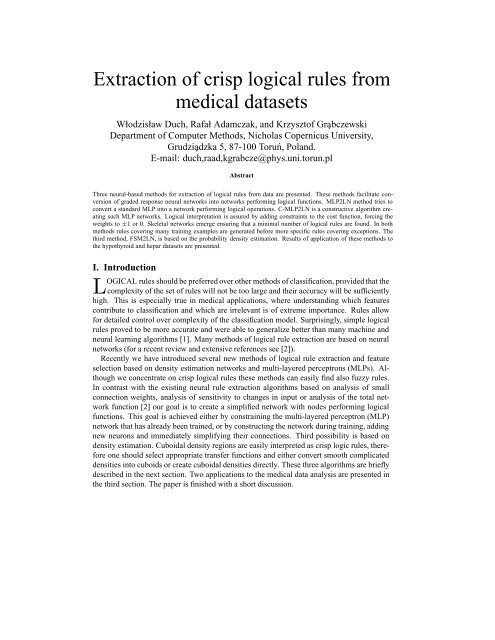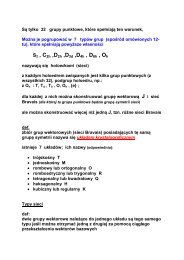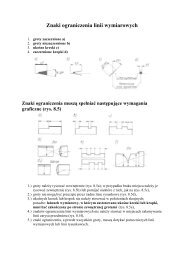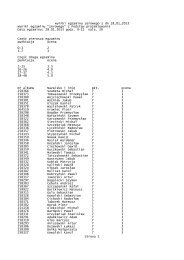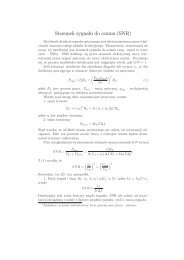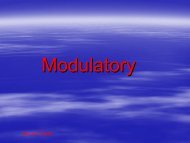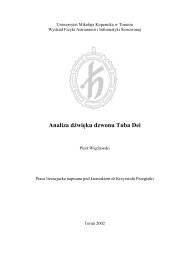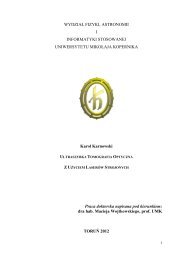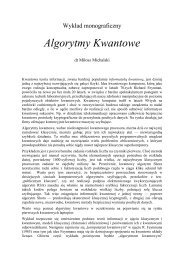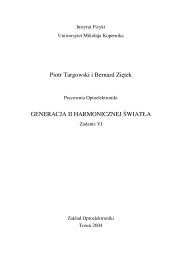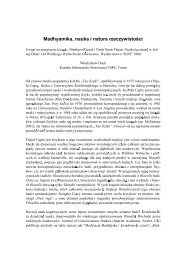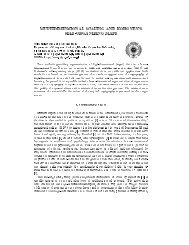Extraction of crisp logical rules from medical datasets - ResearchGate
Extraction of crisp logical rules from medical datasets - ResearchGate
Extraction of crisp logical rules from medical datasets - ResearchGate
Create successful ePaper yourself
Turn your PDF publications into a flip-book with our unique Google optimized e-Paper software.
<strong>Extraction</strong> <strong>of</strong> <strong>crisp</strong> <strong>logical</strong> <strong>rules</strong> <strong>from</strong><strong>medical</strong> <strong>datasets</strong>Włodzisław Duch, Rafał Adamczak, and Krzyszt<strong>of</strong> Gra¸bczewskiDepartment <strong>of</strong> Computer Methods, Nicholas Copernicus University,Grudzia¸dzka 5, 87-100 Toruń, Poland.E-mail: duch,raad,kgrabcze@phys.uni.torun.plAbstractThree neural-based methods for extraction <strong>of</strong> <strong>logical</strong> <strong>rules</strong> <strong>from</strong> data are presented. These methods facilitate conversion<strong>of</strong> graded response neural networks into networks performing <strong>logical</strong> functions. MLP2LN method tries toconvert a standard MLP into a network performing <strong>logical</strong> operations. C-MLP2LN is a constructive algorithm creatingsuch MLP networks. Logical interpretation is assured by adding constraints to the cost function, forcing theweights to ±1 or 0. Skeletal networks emerge ensuring that a minimal number <strong>of</strong> <strong>logical</strong> <strong>rules</strong> are found. In bothmethods <strong>rules</strong> covering many training examples are generated before more specific <strong>rules</strong> covering exceptions. Thethird method, FSM2LN, is based on the probability density estimation. Results <strong>of</strong> application <strong>of</strong> these methods tothe hypothyroid and hepar <strong>datasets</strong> are presented.I. IntroductionLOGICAL <strong>rules</strong> should be preferred over other methods <strong>of</strong> classification, provided that thecomplexity <strong>of</strong> the set <strong>of</strong> <strong>rules</strong> will not be too large and their accuracy will be sufficientlyhigh. This is especially true in <strong>medical</strong> applications, where understanding which featurescontribute to classification and which are irrelevant is <strong>of</strong> extreme importance. Rules allowfor detailed control over complexity <strong>of</strong> the classification model. Surprisingly, simple <strong>logical</strong><strong>rules</strong> proved to be more accurate and were able to generalize better than many machine andneural learning algorithms [1]. Many methods <strong>of</strong> <strong>logical</strong> rule extraction are based on neuralnetworks (for a recent review and extensive references see [2]).Recently we have introduced several new methods <strong>of</strong> <strong>logical</strong> rule extraction and featureselection based on density estimation networks and multi-layered perceptrons (MLPs). Althoughwe concentrate on <strong>crisp</strong> <strong>logical</strong> <strong>rules</strong> these methods can easily find also fuzzy <strong>rules</strong>.In contrast with the existing neural rule extraction algorithms based on analysis <strong>of</strong> smallconnection weights, analysis <strong>of</strong> sensitivity to changes in input or analysis <strong>of</strong> the total networkfunction [2] our goal is to create a simplified network with nodes performing <strong>logical</strong>functions. This goal is achieved either by constraining the multi-layered perceptron (MLP)network that has already been trained, or by constructing the network during training, addingnew neurons and immediately simplifying their connections. Third possibility is based ondensity estimation. Cuboidal density regions are easily interpreted as <strong>crisp</strong> logic <strong>rules</strong>, thereforeone should select appropriate transfer functions and either convert smooth complicateddensities into cuboids or create cuboidal densities directly. These three algorithms are brieflydescribed in the next section. Two applications to the <strong>medical</strong> data analysis are presented inthe third section. The paper is finished with a short discussion.
II. Three rule extraction algorithmsPreliminary: linguistic variables. Logical <strong>rules</strong> require symbolic inputs (linguistic variables).If the input data components x i are real numbers finding optimal linguistic variablesis a part <strong>of</strong> the classification problem. Density estimation networks provide linguistic variables<strong>from</strong> analysis <strong>of</strong> response <strong>of</strong> network nodes. The inputs <strong>from</strong> features giving strongresponse along the whole range <strong>of</strong> data are irrelevant and should be removed. The range <strong>of</strong>values taken by continuous inputs may also be partitioned into distinct (for <strong>crisp</strong> logic) sets byanalysis <strong>of</strong> class-membership histograms. The initial linguistic variable boundary points areoptimized after the <strong>rules</strong> are found and the whole rule extraction process is repeated with newlinguistic variables. MLPs may find linguistic variables using a combination <strong>of</strong> two neurons,called here an L-unit, performing for each continuous input a “window-type” function:s ∗ (x; b, b ′ )=σ(x − b)(1 − σ(x − b ′ )); s + (x; b, b ′ )=σ(x − b) − σ(x − b ′ ) (1)where the gain <strong>of</strong> the sigmoidal functions σ(x) reaches a very high value during learning,changing s(x; b, b ′ ) into a step-like <strong>logical</strong> function. This function has two biases which maybe treated as boundaries defining linguistic variable (l = true) ≡ (x ∈ [b, b ′ ]) [3].MLP2LN method. Logical <strong>rules</strong> giving classification results corresponding to the trained,multi-layered network, are required. MLP network is modified by retraining it while theslopes <strong>of</strong> sigmoidal functions are gradually increased and the weights simplified. Integerweight values are enforced: 0 for irrelevant inputs, +1 for features that must be present and−1 for features that must be absent. This is achieved by modifying the error function:E(W )=E 0 (W )+ λ 12∑i,jW 2ij + λ 22∑i,jW 2ij(W ij − 1) 2 (W ij +1) 2 (2)where E 0 (W ) is the standard quadratic error measure, the second term with λ 1 leads toa large number <strong>of</strong> zero weights, i.e. elimination <strong>of</strong> irrelevant features, and the third termvanishes for weights equal to 0 or ±1. Similarly as in the case <strong>of</strong> weight pruning techniquesin the backpropagation algorithm these terms lead to the additional change <strong>of</strong> weights:∆W ij = λ 1 W ij + λ 2 W ij (Wij 2 − 1)(3W ij 2 − 1) (3)where λ 1 and λ 2 scale the relative importance <strong>of</strong> auxiliary conditions. This form <strong>of</strong> errorfunction has two advantages: independent parameters control enforcing <strong>of</strong> 0 and ±1 weights,and an interpretation <strong>of</strong> this function <strong>from</strong> the Bayesian point <strong>of</strong> view [4] is straightforward.It defines our prior knowledge about the probability distribution P (W |M) <strong>of</strong> the weights inour model M. A network trained on classification tasks should give <strong>crisp</strong> <strong>logical</strong> decision“yes”, “no” or “irrelevant”, therefore a priori conditional probability [4] is:P (W |M) =Z(α) −1 e −αEa(W |M) ∝ ∏ ije −αW 2 ij (Wij −1)2 (W ij +1) 2 (4)To find <strong>logical</strong> <strong>rules</strong> giving classifications equivalent to those <strong>of</strong> a trained MLP networknew error function Eq. (2) with relatively large values <strong>of</strong> regularization parameters λ 1 ,λ 2
is used for retraining. Typical MLP network has many irrelevant connections with smallweights and regularization terms initially increase the error. After retraining a skeletal networkemerges, with a few connections left. Such network is capable <strong>of</strong> rough classificationperforming simple <strong>logical</strong> operations. This skeletal network is inserted into the original networkand its weights and biases are kept frozen. Modified MLP is now retrained again withsmaller regularization parameters. After several cycles <strong>of</strong> retraining and modification theoriginal network is changed into a simplified MLP performing <strong>logical</strong> operations that approximateoriginal classifications.C-MLP2LN method. In this approach a single hidden layer skeleton MLP is constructed.One hidden neuron per output class is created and the modified error function minimizedduring training on all data until convergence is reached. The remaining non-zero weightsand the thresholds obtained are then analyzed and the first group <strong>of</strong> <strong>logical</strong> <strong>rules</strong> is found,covering the most common input-output relations. The input data correctly handled by thefirst group <strong>of</strong> neurons do not contribute to the error, therefore the weights <strong>of</strong> these neuronsare kept frozen during further training. A second group <strong>of</strong> neurons is added and trained onthe remaining data. This process is repeated until a set <strong>of</strong> <strong>rules</strong> R 1 ∨ R 2 ... ∨ R n capable<strong>of</strong> satisfactory classification is found, or until the number <strong>of</strong> cases correctly classified by agiven new neuron drops below certain minimum. Neurons handling only few specific trainingcases model noise rather than regularities in the data, and thus should be deleted. The outputneuron for each class is connected to the hidden neurons created for that class, performing asimple summation <strong>of</strong> the incoming signals. Logical <strong>rules</strong> are sometimes simpler if, in a smallnumber <strong>of</strong> cases, wrong classifications by a newly added neuron is allowed. These cases aretreated as exceptions to the <strong>rules</strong>. The set <strong>of</strong> extracted <strong>logical</strong> <strong>rules</strong> has then a hierarchicalorder. Rules handling exceptional cases, placed at the top <strong>of</strong> hierarchy, are applied first.<strong>Extraction</strong> <strong>of</strong> <strong>rules</strong> <strong>from</strong> skeleton network with small number <strong>of</strong> integer connections isquite simple. For each neuron non-zero inputs define levels <strong>of</strong> a search tree, and values <strong>of</strong>linguistic variables define possible branches <strong>of</strong> this tree. To each node <strong>of</strong> the search tree acontribution to the activation <strong>of</strong> neuron is assigned. Since at each level maximum activationthat lower levels may contribute is known, nodes that do not lead to activations larger thanthreshold are quickly deleted. Rules obtained by both MLP2LN algorithms are ordered,starting with the <strong>rules</strong> that are used most <strong>of</strong>ten and ending with the <strong>rules</strong> that handle only afew cases. Quality <strong>of</strong> a set <strong>of</strong> <strong>rules</strong> is checked using test data – an optimal balance betweenthe number <strong>of</strong> <strong>rules</strong> and the generalization error is usually obtained when only the <strong>rules</strong> thatclassify larger number <strong>of</strong> cases are retained. The final solution may be presented as a set <strong>of</strong><strong>rules</strong> or as a network <strong>of</strong> nodes performing <strong>logical</strong> functions, with hidden neurons realizingthe <strong>rules</strong> and the hidden-output neuron weights all set to ±1.FSM2LN method. It is well known that RBF networks with Gaussian functions are equivalentto the fuzzy logic systems with Gaussian membership functions [5]. To obtain <strong>crisp</strong>logic one can either use rectangular basis functions [6] or use transfer functions that maybe smoothly changed into functions with cuboidal contour surfaces, for example products <strong>of</strong>L-units defined in Eq. (1). Such functions are separable, but not radial, therefore we use theFeature Space Mapping (FSM) density estimation constructive network [7] instead <strong>of</strong> RBF.The slopes <strong>of</strong> sigmoidal functions are gradually increased during the training process, allowingfor smooth transition <strong>from</strong> fuzzy to <strong>crisp</strong> <strong>rules</strong>. Feature selection is performed by addinga penalty term for small dispersions to the error function:
N∑E(V )=E 0 (V )+λ 1/(1 + σi 2 ) (5)where V represents all adaptive parameters, such as positions and dispersions σ i = |b i −b ′ i |<strong>of</strong> localized units, and the sum runs over all active inputs for the node that is most active uponpresentation <strong>of</strong> a given training vector. The penalty term encourages dispersions to grow – ifσ i includes the whole range <strong>of</strong> input data the connection to x i is deleted. After the trainingeach node has class label and represents a cuboid in relevant dimensions <strong>of</strong> the input subspace,easily interpreted as <strong>logical</strong> conditions for a given class. An alternative approach is to testhow much the nodes may expand without changing the classification error.III. Results for the hypothyroid and hepar <strong>datasets</strong>The hypothyroid dataset was created <strong>from</strong> real <strong>medical</strong> tests screening for hypothyroidproblems [8]. Since most people were healthy 92.5% <strong>of</strong> cases belong to the normal group,and 8% <strong>of</strong> cases belonging to the primary hypothyroid or compensated hypothyroid group.21 <strong>medical</strong> tests were made in most cases, with 6 continuous and 15 binary values, and about10% <strong>of</strong> values missing. A total <strong>of</strong> 3772 cases are given for training (results <strong>from</strong> one year)and 3428 cases for testing (results <strong>from</strong> the next year). Thus <strong>from</strong> the classification point <strong>of</strong>view this is a 3 class problem with 22 attributes.Many neural classifiers have been tried on this data, giving accuracies up to 98.5% onthe test set. Schiffman et.al. [9] optimized about 15 MLPs trained with different variants<strong>of</strong> backpropagation and cascade correlation algorithms. In addition tedious genetic optimizationshave been performed on many MLP network architectures. The best results <strong>of</strong> this study[9] are included in Table I, together with the results obtained using k-NN, decision trees andstatistical classification techniques [1].We have created an MLP network using C-MLP2LN approach. Since there are 3 classesonly two outputs are needed, the third class (normal) is treated as “else” or not the first two. Itwas relatively easy to find the important features: FTI, TSH, T3 values, on thyroxineand thyroid surgery. For the first class one neuron was created, giving 3 <strong>rules</strong>,but one <strong>of</strong> these <strong>rules</strong> classifies only one vector, in addition erroneously. This is quite commonsituation and therefore <strong>rules</strong> obtained after the weight analysis should be simplified andchecked directly on the data. Initially 4 <strong>rules</strong> are found, classifying correctly 98.4% <strong>of</strong> thetraining cases and 98.0% <strong>of</strong> the test cases. Linguistic variables were optimized and all conditionschecked to find out if they could be dropped without the change <strong>of</strong> classification error onthe test data. Optimization <strong>of</strong> linguistic variables is easily done by changing the cut<strong>of</strong>f valuesuntil the classification error is minimized. Rule extraction process (network retraining andoptimization) is repeated with new linguistic variables, until this iterative process converges.After this iterative optimization the final <strong>rules</strong> are:R11: TSH ≥ 0.029 ∧ FTI < 0.063R12: TSH ∈ [0.0061,0.029) ∧ FTI 0.0061 ∧ FTI ∈ [0.0644,0.018)The E21 rule is an exception to the rule R21, which means that it is checked first and if it istrue other <strong>rules</strong> are not checked. With these <strong>rules</strong> we get 99.68% accuracy on the training seti
and 99.07% accuracy on the test set. These results are similar to those found using heuristicversion <strong>of</strong> PVM method by Weiss and Kapouleas [1]. The differences among PVM, CARTand MLP2LN are rather small, but other methods, such as well-optimized MLP or cascadecorrelation classifiers, give significantly worse results.FSM2LN for this dataset generated 24 <strong>rules</strong>, but these <strong>rules</strong> used more features and werenot so accurate (98% on the test set) as MLP2LN <strong>rules</strong>.TABLE IClassification results for various classifiers applied to the thyroid dataset.Method Training set accuracy % Test set accuracy %BP+conjugate gradient 94.6 93.8Best Backpropagation 99.1 97.6RPROP 99.6 98.0Quickprop 99.6 98.3BP+ genetic optimization 99.4 98.4Local adaptation rates 99.6 98.5Cascade correlation 100.0 98.5k-NN 100.0 95.3Bayes rule 97.0 96.1PVM 99.8 99.3CART (decision tree) 99.8 99.4FSM2LN <strong>rules</strong> 99.6 98.0MLP2LN <strong>rules</strong> 99.7 99.1The Hepar dataset was collected by dr. H. Wasyluk and co-workers <strong>from</strong> the PostgraduateMedical Center in Warsaw, and contains 570 cases described by 119 values <strong>of</strong> <strong>medical</strong> testsand other features. These vectors are divided into 16 classes corresponding to different types<strong>of</strong> liver disease. The data has not yet been analyzed previously. Small number <strong>of</strong> casesbelonging to several classes (only 2 in class 16, or 5 in classes 3 and 9, etc.) does notallow for reliable classification <strong>of</strong> all data. Moreover, the data is not divided into the trainingand the test set and since some classes do not have enough samples it is hard to make suchpartitioning.Analysis <strong>of</strong> histograms in one and two dimensions does not yield any hints for good linguisticvariables. Therefore we have used FSM2LN approach to find out the relevant features.Selecting a target <strong>of</strong> 96% accuracy the number <strong>of</strong> neurons (representing <strong>rules</strong>) created aftertraining was 170, most <strong>of</strong> them covering only a few data vectors. Lowering the target accuracyto 90% leads to elimination <strong>of</strong> only 10 neurons - this shows that complexity <strong>of</strong> datarepresentation by FSM is appropriate. Rectangular basis functions were used to create FSMclusters and 73 out <strong>of</strong> 119 features were found relevant.It is dangerous to select test vectors <strong>from</strong> Hepar data by random sampling since some <strong>of</strong>the classes may end up with very few representatives in the training set. To test generalization<strong>of</strong> the FSM network vectors belonging to five largest classes (more than 50 vectors in eachclass), comprising 2/3 <strong>of</strong> all data (a total <strong>of</strong> 370 vectors), were selected. 50% <strong>of</strong> these vectorswere used for training and the rest for testing. Assuming the target <strong>of</strong> 94% accuracy onthe training part best results <strong>of</strong> classification on the test set were only 58%, with lower test
esults for other target accuracies. Much lower classification accuracies are obtained if thewhole data is divided in half or if 20% <strong>of</strong> all data is randomly selected as a test set.We have tried to find general trends in the data using MLP2LN, but the number <strong>of</strong> <strong>rules</strong>generated in this way was quite large. The most general rule, describing correctly 30 cases(one erroneously), is: IF (F5 ON and F29 OFF and F81 ∈ [669,3982]) THEN Class 13IV. SummaryNew methods for extraction <strong>of</strong> <strong>logical</strong> <strong>rules</strong> with the help <strong>of</strong> neural classifiers have beenpresented and applied to two <strong>medical</strong> <strong>datasets</strong>. These methods have many advantages. Crispand fuzzy <strong>rules</strong> may be obtained, <strong>rules</strong> are ordered <strong>from</strong> the most common to more specialized,hierarchy <strong>of</strong> <strong>rules</strong> and exceptions is established, overfitting is avoided by droppingmore specialized <strong>rules</strong> and the accuracy is frequently better than given by other (neural andstatistical) approaches. Rules obtained by MLP2LN methods require careful analysis andsometimes additional optimization <strong>of</strong> linguistic variables. Hierarchy <strong>of</strong> <strong>rules</strong> and exceptionsgives natural flexibility to the <strong>rules</strong> derived in our approach, uncommon in other approaches.One concept that is worth more attention is the stability <strong>of</strong> <strong>rules</strong> (and other classification systems).Rules are brittle if a small change in the input data leads to a different set <strong>of</strong> <strong>rules</strong> orto large errors. The choice <strong>of</strong> linguistic variables is most important for stability <strong>of</strong> <strong>rules</strong>. Thisis true in the density networks as well as in MLPs. In FSM2LN the penalty Eq. (5) used toeliminate input features is also useful to stabilize the <strong>rules</strong>. In MLP2LN linguistic variablesare optimized using extracted <strong>rules</strong> and the rule extraction process is iteratively repeated withnew, optimized variables.Results obtained for the hypothyroid dataset are better than those obtained <strong>from</strong> sophisticatedneural and other classifiers and similar to the PVM <strong>rules</strong> [1] (computationally quitedemanding and feasible only if there are a few dominating features) and CART decision tree,which is not so easy to interpret. Results for the Hepar dataset are inconclusive. We wouldbe surprised if a compact representation <strong>of</strong> this data exists. Probably the tests performed donot contain enough information to allow for reliable classification in this case.Acknowledgments: Support by the Polish Committee for Scientific Research, grant number8T11F00308, is gratefully acknowledged.References[1] S.M. Weiss, I. Kapouleas, An empirical comparison <strong>of</strong> pattern recognition, neural nets and machine learningclassification methods, in: J.W. Shavlik and T.G. Dietterich, Readings in Machine Learning, Morgan KauffmanPubl, CA 1990[2] R. Andrews, J. Diederich, A.B. Tickle, A Survey and Critique <strong>of</strong> Techniques for Extracting Rules <strong>from</strong> TrainedArtificial Neural Networks, Knowledge-Based Systems 8 (1995) 373–389[3] W. Duch, R. Adamczak, K. Gra¸bczewski, Constrained backpropagation for feature selection and extraction <strong>of</strong><strong>logical</strong> <strong>rules</strong>, Proc. <strong>of</strong> Colloquia in AI,Łódź, Poland, pp. 163-170, 1996[4] D.J. MacKay, A practical Bayesian framework for backpropagation networks, Neural Comp. 4 (1992) 448-472[5] J-S. R. Jang, C.T. Sun, Functional Equivalence Between Radial Basis Function Neural Networks and FuzzyInference Systems, IEEE Trans. on Neural Networks, vol. 4, pp. 156-158, 1993.[6] M. Berthold, K. Huber, Building Precise Classifiers with Automatic rule <strong>Extraction</strong>, in: Proc. <strong>of</strong> the IEEEICNN, Perth, Vol. 3, pp. 1263-1268, 1995.[7] W. Duch, G.H.F. Diercksen, Feature Space Mapping as a universal adaptive system, Computer Physics Communications,87 (1995) 341–371[8] C.J. Mertz, P.M. Murphy, UCI repository <strong>of</strong> machine learning databases, http://www.ics.uci.edu/pub/machinelearning-databases.
[9] W. Schiffmann, M. Joost, R. Werner, Comparison <strong>of</strong> optimized backpropagation algorithms, ESANN ’93,Brussels 1993, pp. 97-104; Synthesis and Performance Analysis <strong>of</strong> Multilayer Neural Network Architectures,Tech. Rep. 15/1992, available in neuroprose as schiff.gann.ps.Z


